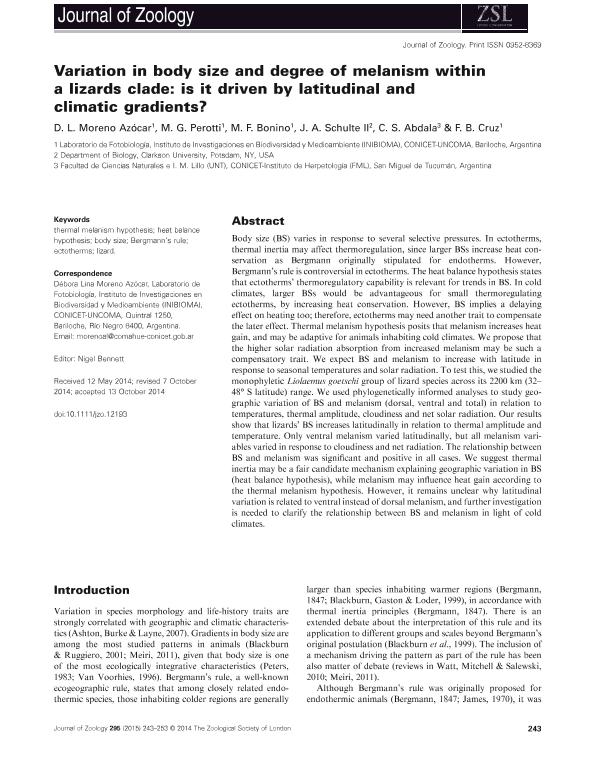Mostrar el registro sencillo del ítem
dc.contributor.author
Moreno Azócar, Débora Lina

dc.contributor.author
Perotti, Maria Gabriela

dc.contributor.author
Bonino, Marcelo Fabián

dc.contributor.author
Schulte, James
dc.contributor.author
Abdala, Cristian Simón

dc.contributor.author
Cruz, Felix Benjamin

dc.date.available
2017-01-30T20:18:25Z
dc.date.issued
2015-04
dc.identifier.citation
Moreno Azócar, Débora Lina; Perotti, Maria Gabriela; Bonino, Marcelo Fabián; Schulte, James; Abdala, Cristian Simón; et al.; Variation in body size and degree of melanism within a lizards clade: is it driven by latitudinal and climatic gradients?; Wiley; Journal Of Zoology; 295; 4; 4-2015; 243-253
dc.identifier.issn
0952-8369
dc.identifier.uri
http://hdl.handle.net/11336/12201
dc.description.abstract
Body size (BS) varies in response to several selective pressures. In ectotherms, thermal inertia may affect thermoregulation, since larger BSs increase heat conservation as Bergmann originally stipulated for endotherms. However, Bergmann’s rule is controversial in ectotherms. The heat balance hypothesis states that ectotherms’ thermoregulatory capability is relevant for trends in BS. In cold climates, larger BSs would be advantageous for small thermoregulating ectotherms, by increasing heat conservation. However, BS implies a delaying effect on heating too; therefore, ectotherms may need another trait to compensate the later effect. Thermal melanism hypothesis posits that melanism increases heat gain, and may be adaptive for animals inhabiting cold climates. We propose that the higher solar radiation absorption from increased melanism may be such a compensatory trait. We expect BS and melanism to increase with latitude in response to seasonal temperatures and solar radiation. To test this, we studied the monophyletic Liolaemus goetschi group of lizard species across its 2200 km (32– 48° S latitude) range. We used phylogenetically informed analyses to study geographic variation of BS and melanism (dorsal, ventral and total) in relation to temperatures, thermal amplitude, cloudiness and net solar radiation. Our results show that lizards’ BS increases latitudinally in relation to thermal amplitude and temperature. Only ventral melanism varied latitudinally, but all melanism variables varied in response to cloudiness and net radiation. The relationship between BS and melanism was significant and positive in all cases. We suggest thermal inertia may be a fair candidate mechanism explaining geographic variation in BS (heat balance hypothesis), while melanism may influence heat gain according to the thermal melanism hypothesis. However, it remains unclear why latitudinal variation is related to ventral instead of dorsal melanism, and further investigation is needed to clarify the relationship between BS and melanism in light of cold climates.
dc.format
application/pdf
dc.language.iso
eng
dc.publisher
Wiley

dc.rights
info:eu-repo/semantics/openAccess
dc.rights.uri
https://creativecommons.org/licenses/by-nc-sa/2.5/ar/
dc.subject
Thermal Melanism Hypothesis
dc.subject
Heat Balance Hypothesis
dc.subject
Body Size
dc.subject
Bergmann'S Rule
dc.subject
Ectotherms
dc.subject
Lizards
dc.subject.classification
Zoología, Ornitología, Entomología, Etología

dc.subject.classification
Ciencias Biológicas

dc.subject.classification
CIENCIAS NATURALES Y EXACTAS

dc.title
Variation in body size and degree of melanism within a lizards clade: is it driven by latitudinal and climatic gradients?
dc.type
info:eu-repo/semantics/article
dc.type
info:ar-repo/semantics/artículo
dc.type
info:eu-repo/semantics/publishedVersion
dc.date.updated
2016-12-12T14:30:13Z
dc.identifier.eissn
1469-7998
dc.journal.volume
295
dc.journal.number
4
dc.journal.pagination
243-253
dc.journal.pais
Estados Unidos

dc.journal.ciudad
Hoboken
dc.description.fil
Fil: Moreno Azócar, Débora Lina. Consejo Nacional de Investigaciones Científicas y Técnicas. Centro Científico Tecnológico Patagonia Norte. Instituto de Investigación En Biodiversidad y Medioambiente; Argentina. Universidad Nacional del Comahue. Centro Regional Universitario Bariloche. Laboratorio de Fotobiologia; Argentina
dc.description.fil
Fil: Perotti, Maria Gabriela. Consejo Nacional de Investigaciones Científicas y Técnicas. Centro Científico Tecnológico Patagonia Norte. Instituto de Investigación En Biodiversidad y Medioambiente; Argentina. Universidad Nacional del Comahue. Centro Regional Universitario Bariloche. Laboratorio de Fotobiologia; Argentina
dc.description.fil
Fil: Bonino, Marcelo Fabián. Consejo Nacional de Investigaciones Científicas y Técnicas. Centro Científico Tecnológico Patagonia Norte. Instituto de Investigación En Biodiversidad y Medioambiente; Argentina. Universidad Nacional del Comahue. Centro Regional Universitario Bariloche. Laboratorio de Fotobiologia; Argentina
dc.description.fil
Fil: Schulte, James. Department of Biology, Clarkson University; Estados Unidos
dc.description.fil
Fil: Abdala, Cristian Simón. Universidad Nacional de Tucumán. Facultad de Ciencias Naturales E Instituto Miguel Lillo; Argentina. Consejo Nacional de Investigaciones Científicas y Técnicas; Argentina. Fundación Miguel Lillo. Dirección de Zoología. Instituto de Herpetología; Argentina
dc.description.fil
Fil: Cruz, Felix Benjamin. Consejo Nacional de Investigaciones Científicas y Técnicas. Centro Científico Tecnológico Patagonia Norte. Instituto de Investigación En Biodiversidad y Medioambiente; Argentina. Universidad Nacional del Comahue. Centro Regional Universitario Bariloche. Laboratorio de Fotobiologia; Argentina
dc.journal.title
Journal Of Zoology

dc.relation.alternativeid
info:eu-repo/semantics/altIdentifier/doi/http://dx.doi.org/10.1111/jzo.12193
dc.relation.alternativeid
info:eu-repo/semantics/altIdentifier/url/http://onlinelibrary.wiley.com/doi/10.1111/jzo.12193/abstract
Archivos asociados
